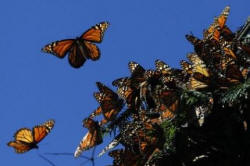|
 Monarch
butterfly eyed for possible U.S. endangered species protection Monarch
butterfly eyed for possible U.S. endangered species protection
 Send a link to a friend
Send a link to a friend
[December 30, 2014]
By Laura Zuckerman
(Reuters) - Monarch butterflies may
warrant U.S. Endangered Species Act protection because of farm-related
habitat loss blamed for sharp declines in cross-country migrations of
the orange-and-black insects, the U.S. Fish and Wildlife Service said on
Monday.
|
|
 Monarch populations are estimated to have fallen by as much as 90
percent during the past two decades because of destruction of
milkweed plants they depend on to lay their eggs and nourish
hatching larvae, according to the Xerces Society for Invertebrate
Conservation. Monarch populations are estimated to have fallen by as much as 90
percent during the past two decades because of destruction of
milkweed plants they depend on to lay their eggs and nourish
hatching larvae, according to the Xerces Society for Invertebrate
Conservation.
The loss of the plant is tied to factors such as increased
cultivation of crops genetically engineered to withstand herbicides
that kill native vegetation, including milkweed, the conservation
group says.
Monarchs, unique among butterflies for the regularity and breadth of
their annual migration, are also threatened by widespread pesticide
use and logging of mountain forests in central Mexico and coastal
California where some of them winter, said biologist Karen
Oberhauser at the University of Minnesota.
 The Fish and Wildlife Service said on Monday a petition requesting
federal protections for monarchs – filed by the Xerces Society and
others – “presents substantial information indicating that listing
may be warranted.”
The agency's initial review will take about a year to complete.
The butterflies, revered for their delicate beauty after emerging
from a jade green chrysalis ornamented by gold stitching, are
roughly divided into two populations in the United States according
to their fall migration patterns.
Monarchs from east of the Continental Divide wing across 3,000 miles
to Mexico, while those from west of the Divide in Rocky Mountain
states like Idaho make a relatively shorter journey to California.
An estimated 1 billion monarchs migrated to Mexico in 1996 compared
with just 35 million last year, according to Marcus Kronforst, a
University of Chicago ecologist who has studied monarchs.
[to top of second column] |

Monarch populations are tracked by an extensive network of
professional and citizen scientists who make up part of the
butterfly’s vast and loyal following.
“Almost every person I’ve talked to about monarchs has expressed a
deep love and admiration for them that was often formed in
childhood,” said Beth Waterbury, regional wildlife biologist for the
Idaho Department of Fish and Game.
The monarchs' navigation remains mysterious. While they are known to
orient themselves by the sun's position, and by the Earth's magnetic
field on cloudy days, it is unclear how new generations find their
way to wintering sites they have never seen, Oberhauser said.
(Reporting by Laura Zuckerman in Salmon, Idaho; Editing by Steve
Gorman and Peter Cooney)
[© 2014 Thomson Reuters. All rights
reserved.] Copyright 2014 Reuters. All rights reserved. This material may not be published,
broadcast, rewritten or redistributed.
 |